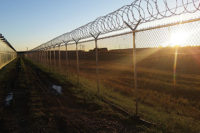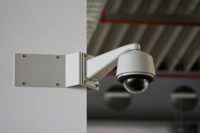As the price gap between analog and IP cameras narrows and benefits to using IP cameras continue to grow, more security executives are investigating how they can incorporate the higher-end technology into their systems without requiring a full, expensive rip and replace. Luckily, many solutions exist to enable that jump over time, whether by taking advantage of renovations or slowly upgrading areas one camera at a time.
According to John Gatsakos of Chicago-based Honeywell Commercial Security Systems dealer Active Alarm, there are plenty of solid reasons to consider migrating to IP surveillance:
- Analog systems could be reaching end of life for support.
- IP cameras could make use of existing network infrastructure, depending on your enterprise.
- Streamlined, networked systems are more manageable and often can be easily accessed from mobile devices or other applications.
- IP surveillance can meet certain compliance needs, including those for encoded video.
- Expandable storage is possible, either through the cloud, different mobile apps or other integrations.
However, not all enterprises are completely sold on switching over entirely. Many may have just invested in an analog-based system in the past decade, and most of their cameras are still functioning satisfactorily. Gatsakos adds that there are additional reasons to stick with analog, besides the cost of a complete migration: for short fields of view, with a fixed shot and no playback zoom required (small areas, for example, like hallways or small entryways), an upgrade to IP is not necessarily required.But for larger atriums or busy thoroughfares in an enterprise, having higher resolution video quality means having access to more detail about potential suspects, clearer evidence after an incident, and better customer service.
Installations of Opportunity
The Bozeman Yellowstone International Airport in Montana was undergoing a massive expansion and subsequent renovation. The original terminal had just 24 analog cameras. After the 250,000-square-foot expansion, the airport has more than 150 IP cameras integrated into the access control system.
“If you’re at the airport and not in the bathroom, you’re on camera, and now recorded in high-definition digital quality,” says Bill Dove, Public Safety Chief for Bozeman Airport. Dove found that the new cameras (Axis Communications and Arecont Vision models) were a lot simpler than analog cameras to install, and the airport’s Exacq video management system enables him to review the camera feeds from his mobile device.
He can also use the cameras to better track or locate people of interest traveling through the airport, monitor baggage claim areas, settle disputes over traffic accidents and resolve complaints about TSA or items missing from checked luggage.
“The more we can help to resolve these issues, the happier our customers are, and they’ll come back to this airport,” he says. Dove plans to continue adding cameras as the need arises, including to monitor vehicular traffic in parking areas.
Jeff Baker, the Technical Systems and Environmental Safety Coordinator at Northern Kentucky University, similarly took advantage of renovations to overhaul surveillance, but not as suddenly as Dove could. Northern Kentucky University had only started installing security cameras in 2008, and analog cameras working with DVRs was what fit the budget at the time. However, as certain needs became apparent – such as more accountability in parking garage accidents or better monitoring in the cash-based Bursar’s Office – investments in higher-level surveillance grew. Renovations in the Bursar’s Office and the on-campus recreational center provided easy access to cables and other infrastructure needed to bring in Sony IP cameras.
“It’s a slow process of migrating to IP, mostly built into renovations and ongoing projects,” says Baker. “We’ve just submitted our goal to replace 20 to 30 analog cameras each year until we’re running full IP, and housing and parking garages are our top priorities.”
While both IP and analog systems are running simultaneously on campus, Baker uses encoders in buildings that feature both systems, essentially assigning an IP address to analog camera feeds so they can be accessed via the IP network to better streamline viewing.
If It Ain’t Broke….
Don’t replace it. This is Mike Mitchell’s policy for camera migration at the 185 United Dairy Farmers convenience stores, based in Ohio. Mitchell, the Security Manager for UDF for the past 13 years, saw the transition from VHS recorders to analog cameras with IP video recorders, and he is now working – store by store, case by case – to swap out analog cameras for IP.
“We were getting more requests from law enforcement for video evidence, and we wanted to be able to provide more digital photos to help identify suspects,” says Mitchell. “We have stores with up to 23 cameras, and some with as few as two or three. We selected two stores as our tests to install Speco IP cameras, and others were outfitted with hybrid recorders, and we’ll replace broken analog cameras with IP ones as needed.
“The cost between IP and analog isn’t a whole lot anymore, but we can’t do all 185 stores at once.”
Mitchell and his team are using the cameras to improve consumer relations at the stores, supporting, investigating or refuting claims, as well as attempting to stem the risk of robberies.
“In stores where we just get one IP camera, we want to make it the front entrance camera. Someone might try to walk out with two 12-packs of beer without paying, and they’ll hide their face going out, but maybe not coming in. We want to use the 2.5 megapixels in an IP camera for that image – to capture that face and use our investigations to deter future robbery or theft attempts,” he says.
Taking the IP Plunge
If you’re ready to jump straight into IP, however, remember to consult with your IT team, says Sean Prather, Campus Safety Department Supervisor for Las Positas College in Livermore, California. “Having good, open communication with your IT department makes a smooth migration to IP possible,” Prather says. “All decisions I made, I did with my IT manager, including demonstrations and bids. The system ties into his server, so I wanted his input and good sound judgment in this decision.”
“We’ve seen a big difference in the quality of video,” he adds. “We can look at specific cars or shirt colors for better descriptions and easier identifications of people or vehicles.”
Using the last funding of a 2005 bond measure, Prather added Axis IP cameras to retrofit older buildings being renovated, or adding them directly to new construction. There are still some analog cameras on the campus, but Prather plans to replace them as they break and as more funding becomes available.
Funding was a key consideration for the surveillance installations at the University of Alabama at Birmingham’s hospital and college campus. At the hospital alone, to rip and replace 800 to 1,000 cameras was estimated to cost upwards of $1.5 million. Instead, working with Genetec on a deal for licensing and video encoders resulted in a $200,000 investment that would make the most of existing analog cameras while adding the benefits of IP recording and monitoring.
“For some of our areas, the analog cameras were still sufficient for what we needed; other areas needed IP. By getting the encoders, we got all of our surveillance onto one platform, which is easier to monitor, easier to provide access to different departments and provides more reliability,” says Ozzie Taylor, Director of Physical Security for the UAB hospital and campus.
One key return-on-investment features from the encoders is the ability to determine if cameras need repairs. According to Physical Security Manager Anthony Banks, “Our cameras are not monitored 24/7, and we never want to access video only to find that the camera was broken. This system alerts us when cameras are malfunctioning so we can have as little downtime as possible. The encoders bring analog and IP worlds together onto one platform, which gives campus law enforcement a better tool to keep our facilities safe.”
The ability to segregate access rights between different users has streamlined the process of monitoring, especially in specialized environments, such as the infant ward of the UAB hospital. Monitors for that area only have access to cameras in that facility, which cuts down on the number of steps they need to find the necessary information or video.
“We had the option to go all IP,” says Banks. “And every facility has to weigh that – weigh the quality of video against the cost and the need for that video. You’re not just looking for a good security decision; you’re looking for a good business decision.”
Want to Learn More?
Find out more about migrating to IP video from the manufacturers in this article:




